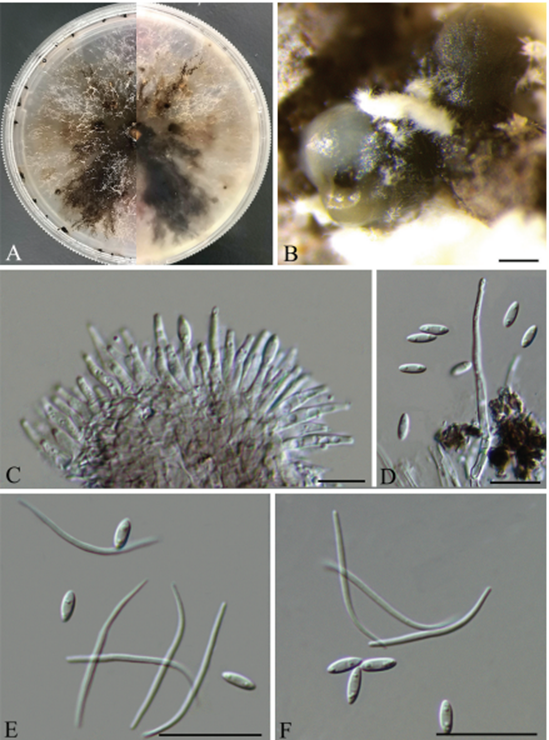 115
115
Diaporthe camelliae-oleiferae Q. Yang, sp. nov. 2021
MycoBank No: 840451
Holotype:
Morphological description
Asexual morph: pycnidia on PDA 500–660 μm in diam., superficial, scattered on PDA, dark brown to black, globose, solitary, or clustered in groups of 3–5 pycnidia. Pale yellow conidial drops exuding from ostioles. Conidiophores reduced to conidiogenous cells. Conidiogenous cells (7.5–)10–14(–15.5) × 1.5–2.3 μm (n = 30), aseptate, cylindrical, straight, densely aggregated, terminal, slightly tapered toward the apex. Alpha conidia 5–6.5(–7.5) × 1.9–2.3 μm (n = 30), aseptate, hyaline, ellipsoidal to fusiform, biguttulate. Beta conidia (26.5–)28.5–31(–33) × 0.8–1.2 µm (n = 30), hyaline, aseptate, filiform, sinuous at one end, eguttulate
Sexual morph: Undetermined.
Cultures: Culture incubated on PDA at 25 °C, originally flat with white fluffy aerial mycelium, becoming brown to black in the centre, with yellowish-cream conidial drops exuding from the ostioles after 20 days.
Habitat:on leaves of Camellia oleifera,
Distribution: . China. Hunan Province: Zhuzhou City
GenBank Accession: its MZ509555; cal MZ504685; bis3 MZ504696; tef1 MZ504702; tub2 MZ504718. Its MZ509556; cal MZ504686 ; bis3 MZ504697; tef1 MZ504708; tub2 MZ504719. Its MZ509557; cal MZ504687; bis3 MZ504698; tef1 MZ504709; tub2 MZ504720.
Notes: Three isolates representing D. camelliae-oleiferae cluster in a well-supported clade (ML/BI=100/1) and appear most closely related to D. pandanicola on Pandanus sp. and D. viniferae on Vitis vinifera. Diaporthe camelliae-oleiferae can be distinguished from D. pandanicola based on ITS and tub2 loci (24/462 in ITS and 11/401 in tub2); from D. viniferae based on ITS, cal, tef1 and tub2 loci (13/453 in ITS, 42/448 in cal, 7/339 in tef1 and 26/402 in tub2). Morphologically, D. camelliae-oleiferae differs from D. viniferae in having shorter alpha conidia (5–6.5 μm vs. 5–8.3 μm) (Manawasinghe et al. 2019); from D. pandanicola in having narrower alpha conidia (1.9–2.3 μm vs. 2.5–3.2 μm) (Huang et al. 2021)
Reference:[1] Mi, L. I. , Zhen, H. E. , Xiaowu, L. , Yonggang, X. , Xuewu, Y. , & Academy, H. F. . (2015). Investigation on resources and appraisal of dominant species of natural enemies in camellia oleifera forests in hunan province. Hunan Forestry Science & Technology.

Diaporthe camelliae-oleiferae (HNZZ027) A Culture on PDA B conidiomata C conidiogenous cells D–F alpha and beta conidia. Scale bars: 200 μm (B); 10 μm (C–D); 20 μm (E, F)

